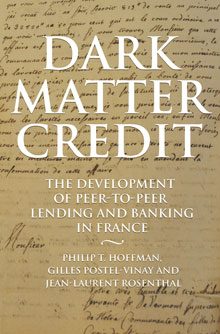Philip T. Hoffman, Gilles Postel-Vinay and Jean-Laurent Rosenthal

Dark Matter Credit: The
Development of Peer-to-
Peer Lending and Banking
in France
Princeton University Press,
Princeton, NJ, 2019, 320 pp., $39.95
Peer-to-peer lending, information networks, collateralized loans, and shadow banking sound like financial innovations that flourished only on the heels of the digital revolution. But Philip T. Hoffman, Gilles Postel-Vinay, and Jean-Laurent Rosenthal show that, contrary to traditional economic thinking, peer-to-peer lending (or banking without banks) dominated credit markets in 17th century France. One-third of French households used this type of credit in 1740. By 1840, peer-to-peer-originated mortgage credit in France was as large as mortgage credit in America in 1950 as a share of GDP.
This book, based on a new data set of French regional notarial archives spanning centuries, shows how credit originated long before bank networks had a meaningful presence outside of Paris and other large cities. While banks focused on financing high-wealth individuals and merchant activities in cities, public notaries in France were the backbone of development of peer-to-peer lending. Owing to regulations dating back to the Middle Ages and the population’s low literacy level, public notaries in France drew up most marriage contracts, certified land sales, and served as fiscal agents in a variety of private transactions. Notaries were able to collect large amounts of information on the wealth of their customers. This insight into potential borrowers’ and lenders’ financial health supported an active loan brokering role among individuals that dominated credit in the mortgage market. It is only when the French government in the second half of the 19th century decided to boost mortgage lending by granting state guarantees to a nationwide institution (named Crédit Foncier) that peer-to-peer mortgage lending started to recede as a share of total lending.
This original and enlightening book questions the connection between bank networks and economic growth. While banks play a unique role in pooling and managing risk, they can price and supply loans properly only if adequate information on debtors’ creditworthiness is readily available. The paucity of public information on creditworthiness is one reason for repeated bank failures throughout the 19th century, and for notaries’ edge in matching lenders and borrowers well into 20th century France.
The book also offers interesting policy takeaways for contemporary observers of financial markets. History shows that a diversified credit ecosystem is one way to ensure the resilience of credit in the face of large shocks. The book demonstrates in particular that the uncertainty and hyperinflation that bankrupted most financial intermediaries in the first years of the French Revolution were somewhat mitigated by the existence of this “paleo shadow banking system” and explains why lending resumed quickly in the first years of the Napoleonic regime.
The authors also have an important message for anyone interested in financial development or other similar topics: focusing on new, alternative data sources may uncover visions of future finance in past events.
Opinions expressed in articles and other materials are those of the authors; they do not necessarily reflect IMF policy.








